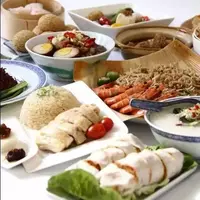The singapore

Singapore is not just a city in Southeast Asia. The Republic of Singapore is a unique city-state that is located on Malaysian islands. In fact, Singapore is part of Malaysia.
The area of Singapore is not large, only 714 sq. Km. However, since the 60s of the XX century, the Singapore authorities have annually added kilometer by kilometer to their territories using labor-intensive and costly technologies for washing up the island territory.
The history of Singapore begins in the 3rd century AD. Then the island bore another name Temasek and was an important trading center. Later, the city fell into decay and was captured by the Portuguese. At the beginning of the 19th century, Singapore became part of the East India Company and soon became a colony of Great Britain.
During World War II, the Japanese were able to cunningly recapture Singapore from the British. English subjects expected an attack by Japanese naval forces from the sea, and the Japanese decided to attack Singapore from land and came from Malaysia.
Until the end of the war, Singapore was under Japanese rule. In the middle of the 20th century, Singapore became part of the Federation of Malaysia. From that moment begins the golden time for Singapore. From the poorest Asian country in the third world, the city-state has become the largest investment, cultural and business center in Southeast Asia.
The indigenous population of Singapore consists of three main groups - Chinese, Malays and descendants of immigrants from India. Therefore, Singaporean recipes are a synthesis of three independent culinary traditions. In the 70s of the XX century, it was with the dishes of Singapore cuisine that the popular direction in cooking began to emerge - fusion.
Chinese, Malay and Indian recipes have a lot in common, so they are all organically intertwined in Singaporean dishes. A characteristic feature of Singaporean cuisine is the sweet and sour taste of almost every dish, the abundance of fish and seafood, as well as seasonings, spices, noodles and rice.
We think that it is worth considering Singaporean cuisine by its main subspecies. Let's start with perhaps Singaporean dishes that were brought in by Chinese culinary experts. Singaporeans eat chicken meat and make a delicious and tender Chinese dish "Chicken fillet with Hainan rice" from chicken breast. If you want a more savoury taste, ask the cook to make you a Hainan duck.
In Asia, they like to cook noodle-based dishes, Singaporean cuisine was no exception. Fried noodles with slices of pork, beef, chicken or seafood are served in broth with the addition of mushrooms, vegetables, seasonings and spicy herbs, as well as Chinese dumplings. The nautical delicacy of Singaporean cuisine is crab in Chile's spicy sauce.
These are dishes for strong foodie spirits or for lovers of very spicy food. The best side dish for such fiery food will be the usual fresh rice. Satai can be attributed to the original Malay recipes of Singaporean cuisine. These are mini kebabs that are made from pre-minced meat and fried over an open fire.
Nasi Lemak's incredibly tasty and hearty Singaporean fried rice. A box is made from a banana leaf and hot rice is folded there with the addition of spices, spices, eggs and nuts. Among the Indian dishes of Singapore cuisine are the famous Roti tortillas, as well as a variety of curries and Tandoori.
Tandur is an ancient Indian stove that baked meat, fish or chicken pre-marinated in a mixture of spicy condiments and spicy herbs. In Singapore, it is customary to drink green tea, which perfectly quenches thirst and gives vigor. Local green tea Tech Tariq is usually mixed with milk in the English manner or with ginger. Green tea with ice is also popular in hot Singapore.
 Español
Español Français
Français Português
Português Русский
Русский 简体中文
简体中文 繁體中文
繁體中文 日本語
日本語 한국어
한국어 العربية
العربية Türkçe
Türkçe Қазақ
Қазақ Deutsch
Deutsch Italiano
Italiano Українська
Українська
